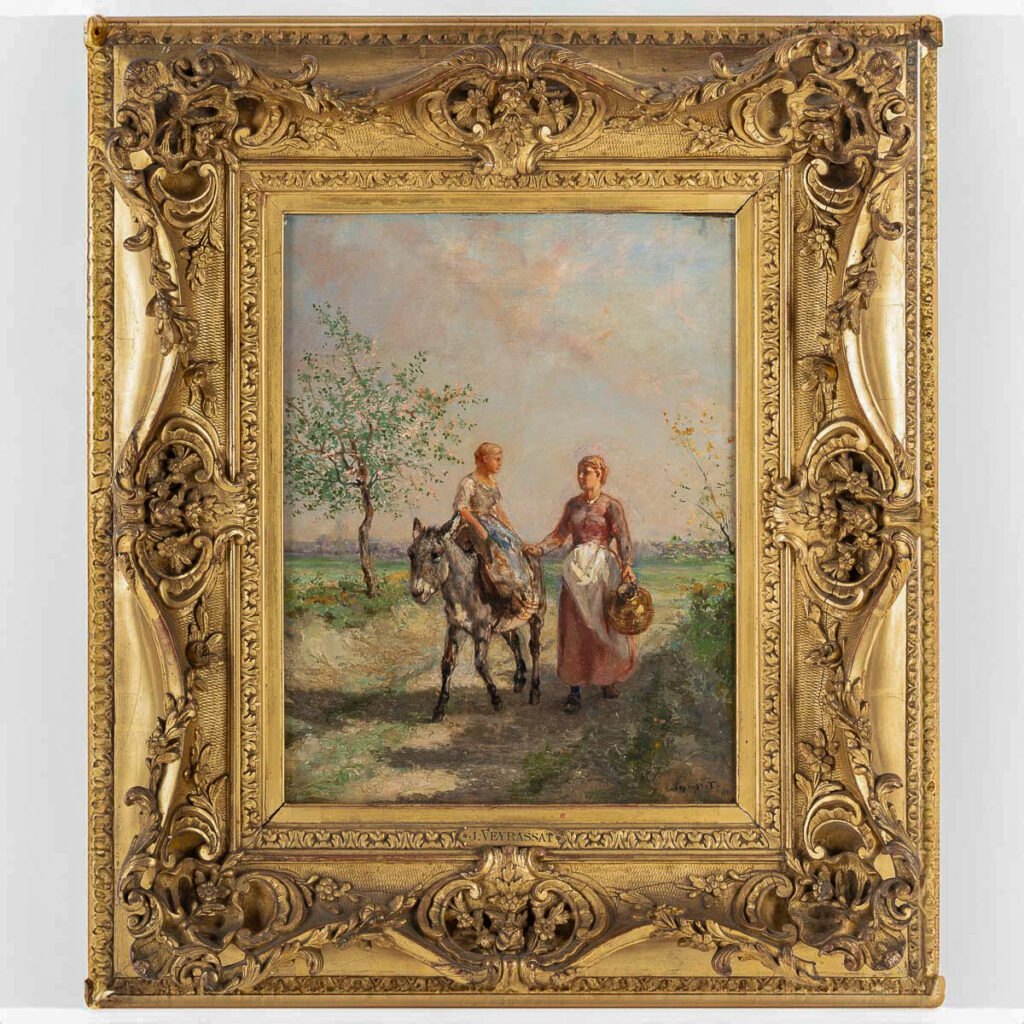Jules Jacques VEYRASSAT (1828-1893) Donkey ride oil on canvas circa 1860.
Jules Jacques Veyrassat is a magnificent painter, sought after by collectors and art lovers alike.
A fine painting, a realistic vision of country life near Barbizon in the mid-19th century. The color palette suggests romanticism, the sweetness of life, simplicity, and beauty.
Our painting signed lower right, is perfectly served by its beautiful original gilded wood frame.
Beautiful Barbizon school of the mid-nineteenth century, circa 1860.
Dimension sans cadre : Hauteur 35 cm – Longueur 27 cm.
Dimensions avec cadre : Hauteur 54 cm – Longueur 46 cm.
In fine original condition, it is served by its beautiful 19th-century carved wood and gilded stucco frame.
Biography:
Jules Jacques Veyrassat, born April 12, 1828, in Paris and died July 2, 1893, in the same city, was a French painter and engraver of the Barbizon School.
Jules Jacques Veyrassat étudie à Paris dans l’atelier d’Henri Lehmann, et expose ses premières œuvres au Salon en 1848.
Veyrassat s’est largement distingué en France par sa peinture, et il attire l’attention quand il commence à travailler en tant que graveur dans les années 1860.
Entre 1866 et 1869, son œuvre gravé lui vaut plusieurs médailles. Le savant britannique Philip Gilbert Hamerton lui demande de collaborer pour plusieurs de ses livres sur l’art de la gravure : Chapters on Animals (1874) avec Karl Bodmer, Etching and Etchers (1880), et une troisième édition à laquelle participent d’autres artistes.
He received a medal for his painting in 1872.
Veyrassat est nommé chevalier de la Légion d’Honneur en 1878. Il est l’un des peintres et graveurs le plus récompensé pour ses travaux sur la nature.
Il est rattaché à l’école d’Ecouen, ville où il a eu une chambre, et suivait les cours de Pierre-Edouard Frère, dont il devint l’ami. Ce sont Pierre-Édouard Frère et Charles-François Daubigny qui l’incitèrent à pratiquer l’eau-forte.
Il est également associé à l’école de Barbizon. Son travail est proche de celui de Charles Jacque ou de Jean-François Millet qu’il a bien connu. Dans un registre réaliste, il fonde son travail sur l’observation de la vie rurale de la France profonde de l’époque. Ses sujets abordent les thèmes de l’élevage et du travail des chevaux dans la vie agricole. Il n’a jamais quitté son pays d’origine, mais sa renommée a fait le tour de toute l’Europe.
Jules Jacques Veyrassat died on July 2, 1893, in the 9th arrondissement of Paris, and is buried in the Père Lachaise cemetery (44th division).
Public collections:
États-Unis.
Baltimore, Walters Art Museum : Femme et enfant agenouillés devant une croix.
San Francisco : De Young Museum ; Legion of Honor.
Williamstown, Clark Institute.
France.
Bézier, Musée des Beaux-Arts : Les Cascarrottes au lavoir, 1863.
Chartres, Musée des Beaux-Arts : Le Repas des moissonneurs, 1862, huile sur toile, 121,5 × 239 cm (Inv. 88.11.1).
Dijon, Musée des Beaux-Arts : Vue d’Auxerre.
Grenoble, Musée de Grenoble : La Fenaison.
La Roche sur Yon, Musée Municipal : Fontaine à Hendaye.
Paris : Musée du Louvre. Musée d’Orsay. Musée du Quay Brandy Jacques Chirac.
Pau, Musée des Beaux-Arts : Chevaux de halage sur la Seine.
Péronne, Musée Alfred-Danicourt : Chevaux au labour.
Reims, Musée des Beaux-Arts : Les Moissonneurs ; La Meule ; Chevaux de halage ; Cour de ferme ; La Moisson.
Rennes, Musée des Beaux-Arts : Le Chargement de la charrette.
Rouen, Musée des Beaux-Arts : Étude algérienne, dite aussi Scène arabe.
Soissons, Musée de Soissons : Cour de ferme.
Toulouse, Musée des Augustins.
Royaume-Uni.
Manchester, Manchester Art Gallery.




